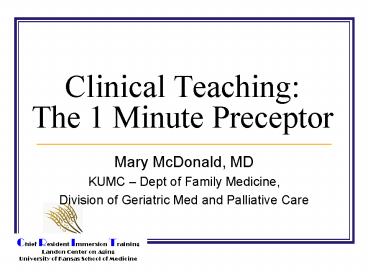Clinical Teaching: The 1 Minute Preceptor - PowerPoint PPT Presentation
1 / 25
Title:
Clinical Teaching: The 1 Minute Preceptor
Description:
KUMC Dept of Family Medicine, Division of Geriatric Med and ... Let's go over holding the otoscope.' Chief Resident Immersion Training. Landon Center on Aging ... – PowerPoint PPT presentation
Number of Views:1557
Avg rating:3.0/5.0
Title: Clinical Teaching: The 1 Minute Preceptor
1
Clinical TeachingThe 1 Minute Preceptor
- Mary McDonald, MD
- KUMC Dept of Family Medicine,
- Division of Geriatric Med and Palliative Care
Chief Resident Immersion Training Landon Center
on Aging University of Kansas School of Medicine
2
Types of Teaching
- Pimping
- Lecture
- Apprenticeship
- Mentorship
Venues for Teaching Inpatient vs Outpatient
3
Pimping
- Often occurs on rounds
- Both teacher and learner are active
- Patient-specific or hypothetical
- Warning Fine line between educational quizzing
and emotional belittlement
4
Lecture
- Teacher active but learner is passive
5
Apprenticeship
- Teacher passive but learner active
- Can occur on teaching rounds
6
Preceptorship
- Teacher active and learner passive
- Occurs in bedside teaching
7
Case PresentationPresenting in Front of the
Patient
- PROs
- CONs
8
Bedside Presentations
- Patients reported
- Doctors spent more time with them (10 vs. 6 min)
- Perceptions of their care were slightly more
favorable - Doctors were more likely to explain problems
adequately - Lehman L, N Eng J Med 19973361150
9
Bedside Presentations
- Bedside presentation patients reported
- Did not provoke worry (88)
- The practice should continue (82)
- Helped them understand their illness (51)
- Too much confusing medical terminology (46)
- Perceived that the purpose of rounds was to teach
and not to provide care (94) - Lehman L, N Eng J Med 19973361150
10
Improving Bedside Presentations
- Patients should be given the opportunity to say
more - All physicians in room should introduce
themselves - Physicians should be more attentive to the
presentations - There should be fewer physicians in the room
- Lehman L, N Eng J Med 19973361150
11
Improving Bedside Presentations
- The physicians should respect the patients
privacy more - Physicians should ask permission to present at
the bedside - Physicians should be seated during the
presentation - Lehman L, N Eng J Med 19973361150
12
How is teaching in an outpatient setting
different?
13
Teaching in the Clinic
- In-depth Lectures
- Seminars
- Formal Educational Sessions
- Extensive Discussion
14
- Efficient and effective ambulatory care teaching
requires that both the student and preceptor
accept the limitations of the outpatient setting. - Extensive discussions of differential diagnosis,
pathophysiology and psychosocial problems are not
possible nor necessarily desirable.
15
Pitfalls in Clinical Case-Based Teaching
- Taking over the case
- Inappropriate lectures
- Insufficient wait-time 3-5 sec
- Pre-programmed answers
- What do you think is going on? Could it be an
ulcer? - Rapid reward
- Effectively shuts down the students thinking
- Pushing past ability
- Persist in carrying the students beyond their
understanding
16
The One Minute Preceptor teaching model was
developed at the Department of Family Medicine at
the University of Washington, Seattle. See
Neher, J. O., Gordon, K. C., Meyer, B.,
Stevens, N. (1992). A five-step "microskills"
model of clinical teaching. Journal of the
American Board of Family Practice, 5, 419-424.
17
(No Transcript)
18
The One-Minute Preceptor
- Get a commitment
- Probe for supporting evidence
- Reinforce what is right
- Give guidance about errors or
omissions - Teach general principles
- Conclusion
19
Commitment
- Why?
- Learner becomes more active in teaching
encounter - Allows you to assess how learner has processed
information presented - Even if answer is incorrect, learning has
occurred - Example
- What do you think is going on here?
- What would you like to do next?
20
Probe for Evidence
- Why?
- Uncovers learners reasoning process for arriving
at the conclusion (Not a lucky guess) - Example
- What factors support your diagnosis?
- Why did you choose that treatment?
21
Reinforce What Was Right
- Why?
- Behavior specific feedback will promote and
encourage desirable clinical behaviors. - Example
- I liked that your differential took into account
the patients age, recent exposures, symptoms.
22
Give Guidance About Errors or Omissions
- Why?
- Behavior specific constructive feedback
discourages incorrect behaviors and corrects
misconceptions. - Example
- During the ear exam the patient seemed
uncomfortable. Lets go over holding the
otoscope.
23
Teach General Rules
- Why?
- Helps learner effectively generalize knowledge
gained from this specific case to other clinical
situations - Example
- Remember 10-15 people are carriers of strep,
which can lead to false positive strep tests.
24
Conclusion
- Why?
- Helps control time and sets clear agenda and
roles for remainder of encounter - Example
- Lets go back in the room and Ill show you how
to get a good throat swab. Tell me when we have
the results, and Ill watch you go over the
treatment plan.
25
Adapted from Materials
- Effective Clinical Teaching, Rohan Jeyarajah, MD
and Hari Raja, MD - Lehman LS,et.al. The effect of bedside case
presentations on patients perception of their
medical care. NEJM 19973361150. - The One Minute PreceptorTime Efficient
Teaching in Clinical Practice. Preceptor
Development Program, developed by MAHEC. Funded
by HRSA Family Medicine Training Grant
1D15PD50119-01 - The One-Minute Preceptor The One-Minute
Observation Effective Efficient - Outpatient Clinical Teaching. JHUSOM Department
of Neurology, December 21, 2006

